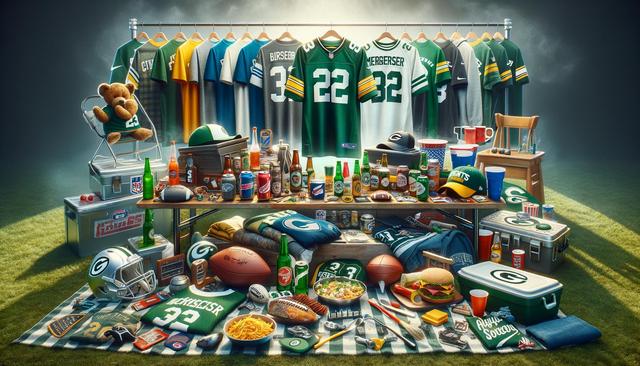From Tailgating to Watch Parties – How Sports Fans Build Communities
Sports fans around the world have a unique way of building communities, turning events into much more than just a game.

The Role of Tailgating in Fan Culture
Tailgating is a cherished tradition among sports fans, often seen as a rite of passage for newcomers and a nostalgic reminder for the seasoned supporters. This pre-game ritual is about more than just food and drinks; it’s a celebration of camaraderie, shared passion, and community spirit. Fans gather in parking lots and open spaces around stadiums, transforming these areas into vibrant hubs of activity. This gathering is an opportunity for fans to express their loyalty and bond over shared interests, creating a sense of belonging that transcends the game itself.
Tailgating often involves elaborate setups, with fans showcasing their creativity and dedication. Some of the common elements include:
- Grills and barbecues: Fans cook and share meals, creating a communal dining experience.
- Team merchandise: Flags, banners, and apparel help fans display their allegiance.
- Games and entertainment: Activities like cornhole, frisbee, and music keep the energy high.
These elements contribute to a sense of community and continuity, as fans return year after year to participate in these shared traditions. Tailgating is not just a precursor to the main event; it’s a cultural phenomenon that enhances the overall experience of being a sports fan.
Watch Parties: Bringing the Stadium Atmosphere Home
For fans who can’t make it to the stadium, watch parties offer an alternative way to engage with the game and fellow supporters. These gatherings, often held in homes, bars, or community centers, aim to recreate the excitement and atmosphere of being present at the game. Watch parties leverage modern technology to bridge the gap between fans and the live action, with large screens and surround sound systems enhancing the viewing experience.
The concept of watch parties has gained popularity as a means of bringing people together, fostering a sense of community even when fans are miles apart from the stadium. Key aspects of successful watch parties include:
- Decor and ambiance: Fans decorate their spaces with team colors and memorabilia to create an immersive environment.
- Food and drinks: Themed snacks and beverages add to the festive atmosphere.
- Interactive elements: Games, trivia, and social media engagement keep fans connected and entertained.
Watch parties have become a staple in fan culture, allowing supporters to share the highs and lows of the game with friends and family. They offer an inclusive space for fans to celebrate their teams, creating lasting memories and strengthening community ties.
Merchandise: A Symbol of Loyalty and Identity
Merchandise plays a crucial role in fan culture, serving as a tangible expression of loyalty and identity. From jerseys and hats to scarves and keychains, sports merchandise allows fans to showcase their support and connect with others who share their passion. Teams and leagues recognize the power of merchandise as a tool for building brand loyalty and fostering a sense of community among fans.
Merchandise is more than just a commercial product; it’s a symbol of belonging and pride. Fans often form emotional attachments to their team gear, viewing it as an extension of their identity. The popularity of sports merchandise is driven by several factors:
- Connection: Wearing team gear helps fans feel connected to their team and fellow supporters.
- Tradition: Merchandise often carries historical significance, linking fans to the legacy of their team.
- Exclusivity: Limited edition items create a sense of exclusivity and prestige among fans.
By purchasing and wearing team merchandise, fans participate in a shared culture and history. It becomes a way to express individuality while also being part of a larger community, uniting fans across different backgrounds and geographies.
Technology and Social Media: Transforming Fan Interaction
Technology and social media have revolutionized the way fans interact with their favorite teams and fellow supporters. Platforms like Twitter, Instagram, and Facebook provide fans with real-time updates and a space to share their thoughts, reactions, and experiences. This digital transformation has expanded the reach of fan culture, allowing supporters from all over the world to connect and engage with one another.
Social media fosters a sense of immediacy and intimacy, breaking down geographical barriers and creating a global community of fans. Key benefits of technology and social media in sports fan culture include:
- Accessibility: Fans have instant access to news, updates, and live game coverage.
- Engagement: Interactive features like polls, hashtags, and live chats enhance fan participation.
- Community building: Online forums and fan groups foster a sense of belonging and shared identity.
The integration of technology into fan culture has also led to the rise of virtual watch parties, where fans can gather online to watch games together, replicating the social experience of being at a live event. This digital shift has made fan culture more inclusive, opening up new opportunities for engagement and interaction.
Conclusion: The Unifying Power of Sports Fan Culture
Sports fan culture is a testament to the unifying power of shared passion and community spirit. From tailgating to watch parties, fans have found innovative ways to connect and celebrate their love for the game. Merchandise, technology, and social media further enhance these connections, creating a global network of supporters who share in the triumphs and tribulations of their teams.
As sports continue to evolve, so too will the ways in which fans engage with the game and each other. The traditions and innovations within fan culture reflect the enduring appeal of sports as a source of joy, identity, and community. Whether gathered in stadiums or connected through digital platforms, sports fans will always find a way to come together, united by their love for the game and each other.